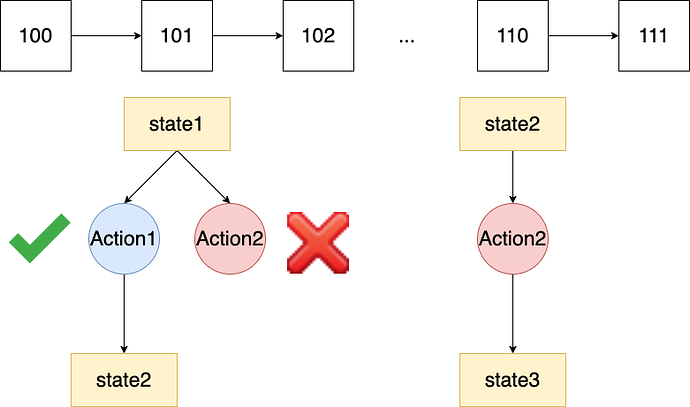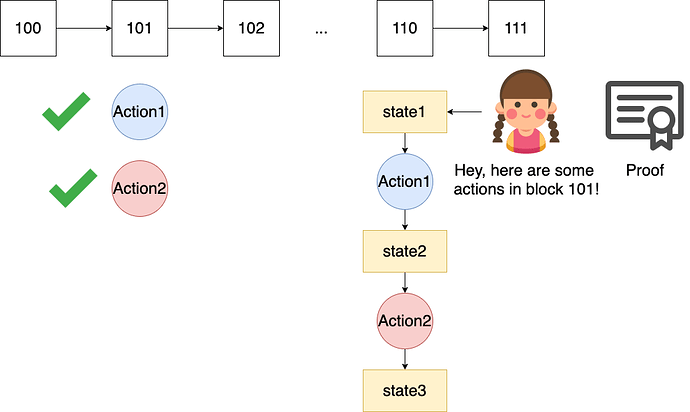This post explores the possibility of building HTLC contracts on CKB.
Basic HTLC
HTLC is, in a nutshell, a smart contract with two ways to unlock it.
- The payer unlocks the cell after a certain block height.
- The payee unlocks the cell with the preimage of a specific hash.
Construction
We can do both of these by putting Timelock and Hash into the lock.args of the cell. So, we can get the data structure of HTLC cell as follows
lock.args:
<Pubkey_payer> <Pubkey_payee> <Timeout> <Hash of preimage>
Witnesses
<Flag> <Signature>
<Flag> <Signature> <preimage>
Flag indicates which way the signer chose to unlock this cell. For payment, the payee add the preimage to the witness . For refunding, the contract will require since of refund transaction is equals to Timelock in the args .
However, you can easily find the flaw in this solution, it doesn’t support micro-payments. This is because CKB cells must have at least 61 CKBytes.
Fused HTLC
I had the idea of fusing the cells together before, so the second version is to use outputs_data to fuse all the HTLCs together to solve the CKB minimum cell size limitation. So we can get the following data structure.
capacity: capacity
lock script:
code_hash: <HTLC>
hash_type: type
args:
<Pubkey_payer> <Pubkey_payee>
<Timeout1> <Hash of preimage1>
<Timeout2> <Hash of preimage2>
...
type script: <Collector type>
data:{
<Payment type1> <Payment amount1>
<Payment type2> <Payment amount2>
}
Witnesses
<Flag> <HTLC_index> <Signature>
<Flag> <HTLC_index> <Signature> <preimage>
In short, every HTLC payment is split into two parts. lock.args stores the information needed for unlocking, while output_data stores the type and amount of assets to be unlocked. At this point, the contract looks for the corresponding HTLC based on the HTLC_index provided by the user and checks if the unlock logic is correct. Nevertheless, this scheme has the state sharing problem, when both Alice and Bob try to unlock two different HTLCs, only one will succeed.
My colleague @driftluo proposed a possible solution. The principal is HTLCs is fused off-chain, but split on-chain. i.e., users should provide the container (61 CKBytes usually) to break down the fused HTLCs when they decide to settle them on-chain. The advantage is users can make payments without container off-chain. However, they still need to lock some CKBytes when HTLCs are on-chain.
Fused HTLC with state sharing
Inspired by Hydra, I have found that some blockchain applications with specific deadlines can share state. First, let’s explain why contracts in UTXO model have state sharing problems. In fact, you can think of a transaction as an action on cell. In UTXO model, action specifies a concrete input cell state where account model does not. Therefore, if there are two action, action1 and action2, both of them want to change state_init of a cell. If action1 is successful, then state_init will be changed into state_changed. It is bad news for action2 since the state is inconsistent with what it expects.
As we can see, two reasons contribute to the problem
- action in UTXO model specifies the input state.
- action takes effect immediately.
The first reason is caused by the natural property of UTXO, so we cannot fix it. But we can solve this problem by removing the second one. The answer is to postpone the effective time of the action.
In a nutshell, we first submit the action to the chain, you can choose to write it to your cell’s output_data. Note that at this point the action does not take effect, it is just a record. Then, after waiting for a specific block height, you prove to the contract that you have previously submitted these actions on the blockchain and ask it to execute them in order.
Moreover, this design introduces a new mechanism to CKB, until. We know that there is a filed called since in CKB transaction, which is utilized to allow some transactions can only be committed after a specific block height or have passed a required time interval. But there is no mechanism about until, which means these transactions can not be submitted from a specific block height. With proof cell, we can implement until mechanism without changing the Layer 1 rules. The rationale is very simple, users can not create valid (before the deadline) proof cell after the deadline.
Another interesting discussion about this mechanism is how to make the proof. There are two choices:
- Put the proof cell in the cell_deps field and add the block hash to header_deps.
- Put the proof cell and merkle proof in the outputs_data field and the block hash to header_deps.
These two schemes have their pros and cons. For the former, the final proof transaction will be succinct, but it requires the proof cell is live, i.e., you can not spend it before the final deadline. For the latter, you can expend it after it is on-chain. However, the final proof transaction may be swollen. You can choose either of them according to your preference.
Then let’s go back to the HTLC scenario and you’ll see that this solves the state sharing problem. The users no longer need to compete for the usage of the cell, but writes preimage directly their own cells. That’s how it works. Next, I’d like to give an example to illustrate it. And I will adopt the merkle proof mechanism in this example.
Example
Suppose Alice wants to pay Bob 10 CKB, 15 UDT1 and 20 UDT2. Expiration times are 200, 250, and 300 blocks height, respectively. Also, let’s assume that both UDT allow the special type script I mentioned in the idea to create and destroy their UDTs. For the simplicity, I start with the settlement phase of GPC have completed, while the Fused HTLC cell is on the chain and alive. Also, I assume that the minimum CKB required for the current cell is 100 CKBytes. Note that at this point the expiration time of the Fused HTLC cell is set to 300 blocks height, and the refund time is set to 350 blocks.
The structure of fused HTLCs cell
Current block height: 150
capacity: 110
lock script:
code_hash: <HTLC>
hash_type: type
args: <Pubkey of Alice> <Pubkey of Bob>
<200> <H1>
<250> <H2>
<300> <H3>
type script: <Collector type>
data:{
<32 * "0"> <10>
<Type hash of UDT1> <UDT1_ENCODER(15)>
<Type hash of UDT2> <UDT2_ENCODER(20)>
}
- 32 * “0” represents this asset is CKB.
-
<UDT1_ENCODER(15)>means it follows the rules of the corresponding type script. For example, if a type script specifies that the first 8 bytes ofoutput_datarepresent an amount. Then the<UDT1_ENCODER(15)>here needs to occupy 8 bytes.
The structure of proof cell
After that, the user simply sends a transaction to modify the data in the output_data before the corresponding block height as follows.
Current block height: 190
capacity: 110
lock script: Secp lock of Bob
type script: nil
data:{
1 && p1
2 && p2
3 && p3
}
1 is the indexer and p1 is preimage of h1 . Please note that here I have submitted all preimages at once for simplicity. In practice, you may not be able to gather them all at the same time. For example, you might receive p3 at 260 blocks, then you should submit p1 and p2 proofs before that to ensure the proof is valid.
Current block height: 190
capacity: 110
lock script: Bob secp lock
type script: nil
data:{
1 && p1
2 && p2
}
----------------------------
Current block height: 260
capacity: 110
lock script: Bob secp lock
type script: nil
data:{
3 && p3
}
At the same time, we call the corresponding transaction T, the block containing T are called B. After committing, the user can clear the data from the cell after the on-chain confirmation period.
The structure of payment transaction
When the block height reaches 200, the user can redeem his money by proving
Current block height: 201
Inputs:
HTLCs Cell:
capacity: 110
lock script:
code_hash: <HTLC>
hash_type: type
args: <Alice pubkey> <Bob pubkey>
<200> <H1>
<250> <H2>
<300> <H3>
type script: <Collector type>
data:{
<32 * "0"> <10>
<Type hash of UDT1> <UDT1_ENCODER(15)>
<Type hash of UDT2> <UDT2_ENCODER(20)>
}
Container cell:
capacity: 500
lock script: Secp lock of Bob
type script: nil
data{
"0x"
}
Outputs:
CKB cell:
capacity: 71
lock script: Secp lock of Bob
type script: nil
data{
"0x"
}
UDT1 cell:
capacity: 100
lock script: Secp lock of Bob
type script: UDT1 type script
data{
<UDT1_ENCODER(15)>
}
UDT2 cell:
capacity: 100
lock script: Secp lock of Bob
type script: UDT2 type script
data{
<UDT2_ENCODER(20)>
}
change cell:
capacity: 228
lock script: Secp lock of Bob
type script: nil
data{
"0x"
}
Witnesses
<The proof transaction T> <Merkle proof that T is in B> <Signature>
<Signature>
Here, Bob proves the existence of the corresponding proof transaction in witnesses . At the same time, we put the hash corresponding to B in the head_deps so that the HTLC script can verify that the block height where B is generated satisfies the requirement. The refund transaction is similar to this one, except that Alice have to wait a little longer. Because Alice got her refund on the condition that “Bob did not complete the proof”, which is hard to prove in blockchain. The solution I use here is that we give priority to Bob to submit the proof, and if Bob does not take action during this period, then we can think the proof did not happen.
However, this scheme requires all the coins in HTLC can not be withdrawn before the last deadline. For example, there are two HTLCs, one will expire at 100 blocks and another will expire at 500 blocks. They can only get their all money after 500 blocks. One naive mitigation is settling HTLCs in batches. If there are HTLCs which will expire at 100, 110, 120, 500. We can set two batches, one includes 100, 110, 120 and another includes 500. Therefore, the deadline of the first batch is 120 blocks. In this case, the lock time of these coins will not be prolonged very much.
Discussion
First, I would like to describe some of the areas of confusion by way of QA.
- In the final stage, if I intentionally choose to submit multiple batches of action to keep modifying the HTLC status, can I intentionally extend the time it takes to get a refund?
First of all, doing so would require the attacker to pay a commission for multiple transactions, which a rational trader would not do. Second, we can solve it with one-shot submission mechanism, you can find the corresponding content in the discussion. This means that each person is only allowed to submit once. If the attacker chooses not to submit the full proof cell, he loses money. Also, because the number of proof cells can be very large, one transaction may not fit. Users can negotiate the number of times they allow each other to submit.
- If there are bi-directional HTLCs, how do I handle them?
Use two cells or develop a more complex sequence of refund and payment.
Then, I would like to discuss the pros and cons of this proposal.
Pros:
- HTLCs can share a single container.
- User can make proof concurrently (state sharing).
Cons
- All funds can not be withdrawn until the latest HTLC expires.
- To perform merle tree validation, the corresponding block B must be mature (after four epochs).
- If there are multiple proof transaction, the size of payment transaction will be massive.
These are my thoughts on the implementation of HTLC on CKB, and I would appreciate any comments and questions you may have. Finally, many thanks to @janx, @doitian and @driftluo for their help and feedback on this topic. @thewawar

